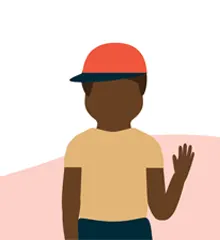Understanding receptive language disorder in your child

Receptive language disorder makes it hard to understand what people say. That can take a toll on kids’ self-esteem and make learning and socializing hard. But with the right support, skills can improve. The more you understand the challenges, the better you can support your child.
You may not yet know if your child has receptive language disorder. But this overview can help answer basic questions you may have. It can also lead you to more in-depth information.
Signs of receptive language disorder
The signs of receptive language disorder can be confusing. That’s partly because the signs can look like other things. For example, a common sign is not following directions. But there are lots of reasons kids don’t follow directions. To spot receptive language disorder, you need to see more than just one of the behaviors.
Here are some of the signs of receptive language disorder:
Tuning out when people talk
Trouble following directions
Trouble answering questions
Interrupting people who are speaking
Often asking people to repeat what they say
Giving answers that are “off”
Misunderstanding what’s said
Not getting jokes
Trouble understanding and learning new vocabulary
Some signs may not even seem like they’re related to language. For example, your child may often get angry or frustrated over little things. Or get upset or anxious when company comes over.
Learn more about the signs of receptive language disorder.
Finding out if your child has receptive language disorder
The first step in diagnosing language disorders is to rule out hearing problems. Trouble with hearing can have a big impact on language skills.
The next step is to have an evaluation for language difficulties. The specialists who do them are called speech-language pathologists (SLPs). They’re also known as speech therapists.
Schools provide language evaluations for free. They’re often done as part of a full evaluation that looks at a wide range of skills. That’s important because language challenges often co-occur with learning disabilities like dyslexia. They’re also common in kids with ADHD.
Find out how to request a free school evaluation.
Some SLPs work outside of school and do private evaluations. Your child’s health care provider may be able to give you a referral. Private evaluations aren’t free. But local colleges that train speech therapists sometimes offer free or low-cost evaluations.
Speech-language evaluations look at different language skills. Some kids who have trouble with understanding language also have a hard time using language (expressive language). When kids struggle with both skills, it’s called mixed receptive-expressive language disorder.
In the evaluation, the SLP will try different strategies to figure out which might work best for your child. The therapist may also interview you. The purpose is to find out how and where the language challenges are impacting your child’s life.
How professionals can help with receptive language disorder
It’s important for kids to get help for receptive language disorder as early as possible. There are no medications for language disorders. The main treatment is speech therapy.
Schools usually provide speech therapy as part of a special education plan called an IEP. Your child may get one-on-one therapy. Or the SLP may work with your child in a small group with kids who have similar challenges.
The therapist will use strategies and activities based on your child’s needs. That might include modeling and giving feedback. The SLP might also use pictures and books or play-based therapy to build language skills.
Get a better idea of how speech therapy works. And learn how social skills groups can help kids who struggle with communication.
How you can help with receptive language disorder
There are many simple ways you can help your child improve language skills. Here are some ideas:
Read picture books together and label the items you see. Talk about what the characters are doing. (If you don’t have time to read to your child, here are other ideas to try.)
Play games with simple, predictable directions, like Simon Says.
Play together, with toys your child chooses. Ask questions and make comments that relate to what you’re doing.
Practice looking at the speaker and resisting interrupting.
Let your child know it’s OK to ask people to repeat themselves.
If your child is getting speech therapy, ask the SLP for suggestions for what you can do at home.
It’s important to help your child build language skills. But you’re also the best person to help your child build self-esteem. Kids who struggle can easily lose confidence and stop trying. And with language disorders in particular, they can feel isolated and withdraw.
Tell your child that everyone has challenges — and strengths. Celebrate successes big and small. Let your child know that language skills can improve with work, and that you’re there to help.
Download “growth mindset” worksheets to help your child stay motivated. And learn how to give praise that builds self-esteem.




